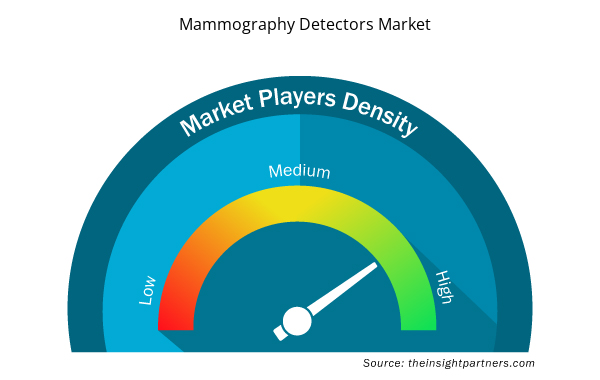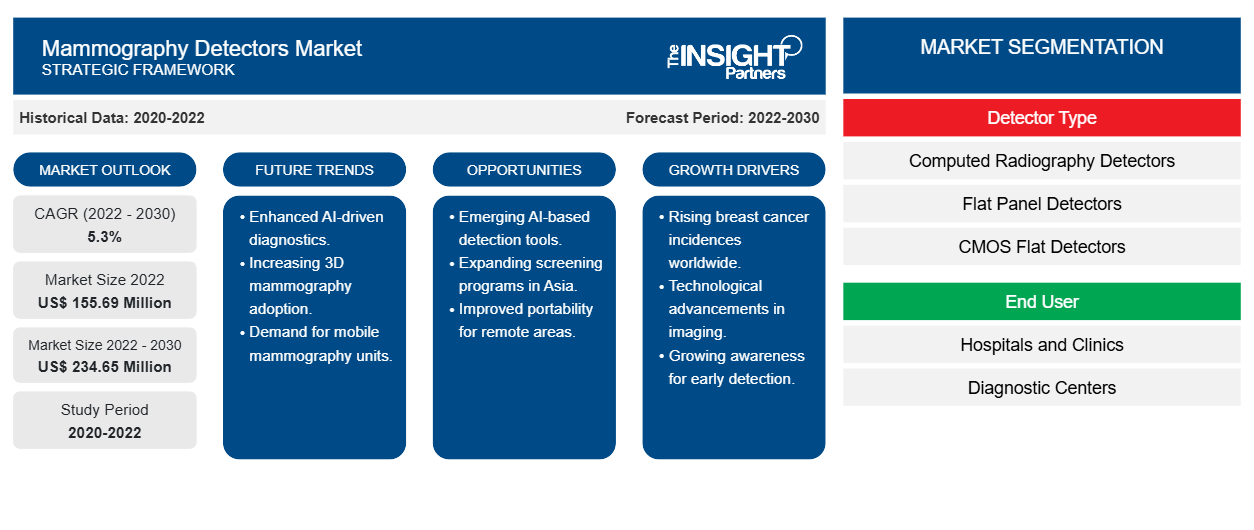[研究报告] 乳房X光检查探测器市场规模预计将从 2022 年的 1.5569 亿美元增长到 2030 年的 2.3465 亿美元;预计 2022-2030 年期间的复合年增长率为 5.3%。
市场洞察和分析师观点:
基于乳房 X 线摄影探测器的成像已成为乳腺癌检测过程中必不可少的一部分。乳房 X 线摄影是一种诊断和筛查技术,它使用低能量 X 射线检查人体乳房,根据明显的肿块或微钙化来判断是否可能患有乳腺癌,从而在早期诊断出病情。乳房 X 线摄影探测器使用低剂量 X 射线在女性出现症状之前识别癌症。市场上有几种乳房 X 线摄影探测器,包括计算机射线探测器、平板探测器和 CMOS 平板探测器。
增长动力:
乳腺癌是世界上诊断率最高的癌症类型。乳腺癌的一些常见症状包括乳头内陷、乳房形状改变、乳房肿块形成、皮肤出现红色或鳞状斑块或乳头疼痛。生活方式改变、荷尔蒙失衡、遗传倾向和环境因素等因素导致乳腺癌患病率上升。根据世界卫生组织的数据,2020 年全球约有 230 万女性被诊断出患有乳腺癌,而 685,000 例导致死亡。国际癌症研究机构预测,到 2040 年,乳腺癌发病率将增加三分之一以上,每年新增病例超过 300 万例;预计每年因该疾病死亡的人数将增加一半以上,达到约 100 万人。乳腺癌的患病率在全球范围内不断上升,导致对用于诊断的乳房 X 线检查探测器市场的需求增加。
乳腺癌是美国最常见的癌症类型之一。Breastcancer.org 在 2022 年 1 月发布的一份报告指出,该国每 8 名女性中就有 1 名(或约 13%)在其一生中会患上浸润性乳腺癌。根据同一来源,2022 年美国女性中发现 287,850 例新的浸润性乳腺癌病例,以及 51,400 例新的非浸润性(原位)乳腺癌病例。同年,该国记录了约 2,710 例男性浸润性乳腺癌病例。大约每 833 名男性中就有 1 人在其一生中面临患乳腺癌的风险。它也是德国女性中最常见的癌症类型。根据 Globocan 2020,2020 年德国报告了近 69,697 例新的乳腺癌病例,占所有已登记癌症病例的 11.1%。该病导致 20,579 人死亡,各年龄段乳腺癌的五年患病率为每 100,000 人口 707.38 人。德国联邦乳腺保护局的乳房 X 线摄影研究表明,尽管乳腺癌治疗取得了重大进展,但仍有约 17,000 名女性死于该病。乳腺癌治疗费用每年近 21.3 亿美元(20 亿欧元)。根据英国国家医疗服务体系的数据,在英国,大约每 7 名女性中就有 1 名在其一生中被诊断出患有乳腺癌。每年,约有 55,000 名女性被诊断出患有乳腺癌。
乳腺癌诊断采用三种成像技术:X 射线乳房 X 光检查(使用低剂量 X 射线系统检查乳房)、超声检查和磁共振成像。乳房 X 光检查是筛查乳房组织以检查是否存在恶性肿瘤的标准诊断和筛查技术。该过程涉及使用低能量 X 射线。乳房 X 光检查检测器是一种使用乳房 X 射线检测和诊断乳腺癌的设备。特殊的 X 射线图像有助于发现乳房组织的异常生长或改变,有助于早期发现乳腺癌。
因此,预计未来几年乳腺癌的发病率将会增加,从而推动乳房 X 线摄影检测器市场的增长,因为乳房 X 线摄影是筛查无症状女性乳腺癌的最有效方法。
定制此报告以满足您的需求
您可以免费定制任何报告,包括本报告的部分内容、国家级分析、Excel 数据包,以及为初创企业和大学提供优惠和折扣
- 获取此报告的关键市场趋势。这个免费样品将包括数据分析,从市场趋势到估计和预测。
报告细分和范围:
乳房 X 线摄影探测器市场根据探测器类型、最终用户和地理位置进行细分。根据探测器类型,市场分为计算机放射探测器、平板探测器、CMOS 平板探测器和其他。乳房 X 线摄影探测器市场按最终用户细分为医院和诊所以及诊断中心。乳房 X 线摄影探测器市场按地理位置细分为北美(美国、加拿大和墨西哥)、欧洲(法国、德国、英国、西班牙、意大利和欧洲其他地区)、亚太地区(中国、印度、日本、澳大利亚、韩国和亚太其他地区)、中东和非洲(沙特阿拉伯、阿联酋、南非和中东和非洲其他地区)以及南美洲和中美洲(巴西、阿根廷和南美洲和中美洲其他地区)。
节段分析:
乳房 X 线摄影探测器市场按探测器类型分为计算机放射探测器、平板探测器、CMOS 平板探测器等。平板探测器细分市场在 2022 年占据了最大的市场份额。预计 CMOS 平板探测器细分市场将在 2022-2030 年期间在乳房 X 线摄影探测器市场中实现最高复合年增长率。
根据最终用户,乳房 X 线摄影探测器市场分为医院和诊所以及诊断中心。2022 年,医院和诊所占据了更大的市场份额,预计在 2022-2030 年期间将实现更高的复合年增长率。
区域分析:
乳房 X 线摄影探测器市场主要分为北美、欧洲、亚太地区、南美和中美以及中东和非洲。2022 年,北美占据了相当大的市场份额。2022 年,美国占据了该地区最大的市场份额。北美市场的增长归因于技术先进的探测器的易得性、乳腺癌病例的增加以及完善的医疗保健基础设施。根据美国疾病控制和预防中心的数据,2020 年美国女性报告了 239,612 例乳腺癌新病例,其中约 42,273 例死亡。每 100,000 名女性中,有 119 例新发乳腺癌病例,近 19 例死于该疾病。根据乳腺癌组织的乳腺癌统计数据,每 8 名女性中就有 1 名(近 12%)在其一生中面临患上浸润性乳腺癌的风险。
由于乳腺癌是加拿大女性中最常见的癌症,也是癌症相关死亡的第二大原因,因此该国对高效诊断方案的需求很高。根据加拿大癌症协会的数据,2022 年约有 28,600 名加拿大女性被诊断出患有乳腺癌,占女性所有新癌症病例的约 25%。据估计,每 8 名加拿大女性中就有 1 名在其一生中会患上乳腺癌。
乳房 X 线摄影探测器市场区域洞察
Insight Partners 的分析师已详尽解释了预测期内影响乳房 X 线摄影探测器市场的区域趋势和因素。本节还讨论了乳房 X 线摄影探测器市场的各个部分和地理位置,包括北美、欧洲、亚太地区、中东和非洲以及南美和中美洲。

- 获取乳房X光检查探测器市场的区域特定数据
乳房 X 线摄影探测器市场报告范围
| 报告属性 | 细节 |
|---|---|
| 2022 年市场规模 | 1.5569亿美元 |
| 2030 年市场规模 | 2.3465亿美元 |
| 全球复合年增长率(2022 - 2030 年) | 5.3% |
| 史料 | 2020-2022 |
| 预测期 | 2022-2030 |
| 涵盖的领域 | 按探测器类型
|
| 覆盖地区和国家 | 北美
|
| 市场领导者和主要公司简介 |
|
市场参与者密度:了解其对商业动态的影响
乳腺造影探测器市场正在快速增长,这得益于终端用户需求的不断增长,而这些需求又源于消费者偏好的不断变化、技术进步以及对产品优势的认识不断提高等因素。随着需求的增加,企业正在扩大其产品范围,进行创新以满足消费者的需求,并利用新兴趋势,从而进一步推动市场增长。
市场参与者密度是指在特定市场或行业内运营的企业或公司的分布情况。它表明在给定市场空间中,相对于其规模或总市场价值,有多少竞争对手(市场参与者)存在。
在乳房X光检查探测器市场运营的主要公司有:
- 安立克公司
- 西门子医疗
- 泰莱达因
- 万睿影像
- 富士控股
免责声明:上面列出的公司没有按照任何特定顺序排列。

- 了解乳房X光检查探测器市场的主要参与者概况
行业发展和未来机遇:
- 2023 年 1 月,Carestream Health, Inc. 推出了用于 CR 乳房 X 线摄影成像系统的 EHR-M3 屏幕,该屏幕具有降低噪音和提高探测器量子效率的特点,可提高图像质量。这款新屏幕是为了替代之前用于 DIRECTVIEW CR 乳房 X 线摄影系统的屏幕而推出的,该系统配备了该公司的乳房 X 线摄影功能。这款新的乳房 X 线摄影软件现已在加拿大、欧洲、南美、澳大利亚、亚洲和世界其他地区推出。
竞争格局和重点公司:
Analogic Corporation、西门子医疗、Teledyne DALSA、Varex Imaging、富士胶片控股、荷兰皇家飞利浦、Hologic、PerkinElmer、锐讯医疗和佳能医疗系统是乳腺造影探测器市场的知名企业。这些公司专注于推出新的高科技产品、改进现有产品和扩大地域范围,以满足全球日益增长的消费者需求。
- 历史分析(2 年)、基准年、预测(7 年)及复合年增长率
- PEST 和 SWOT 分析
- 市场规模价值/数量 - 全球、区域、国家
- 行业和竞争格局
- Excel 数据集



Report Coverage
Revenue forecast, Company Analysis, Industry landscape, Growth factors, and Trends

Segment Covered
This text is related
to segments covered.

Regional Scope
North America, Europe, Asia Pacific, Middle East & Africa, South & Central America

Country Scope
This text is related
to country scope.
常见问题
Early breast cancer detection coupled with technological advancement in detectors design , material, and image processing are driving the global mammography detectors market.
The CAGR value of the mammography detectors during the forecasted period of 2020-2030 is 5.3%.
Global mammography detectors market is segmented by region into North America, Europe, Asia Pacific, Middle East & Africa and South & Central America. The market in North America held the largest market share of US$ 63.97 million in 2022 and is expected to grow at a significant rate during the forecast period. North America mammography detectors is segmented into the US, Canada, and Mexico.
Answer: - The flat panel detector type segment dominated the global mammography detectors and held the largest market share of 46.09% in 2022.
A mammography detector is a device used in mammography, a type of medical imaging that uses low-dose X-rays to create detailed images of the breast. The mammography detector is a key component of the mammography system and is responsible for capturing the X-ray images of the breast tissue. It typically consists of an X-ray detector, such as amorphous selenium or amorphous silicon, which converts X-ray photons into electrical signals that can be used to create digital images. These detectors are designed to provide high image quality while minimizing radiation exposure to the patient.
The mammography detectors majorly consists of the players including Analogic Corporation, Siemens Healthineers, Teledyne DALSA, Varex Imaging, Fujifilm Holdings, Koninklijke Philips NV, Hologic, Inc., PerkinElmer, Carestream Health, and Canon Medical Systems.
Trends and growth analysis reports related to Life Sciences : READ MORE..
The List of Companies - Mammography Detectors Market
- Analogic Corporation
- Siemens Healthineers
- Teledyne DALSA
- Varex Imaging
- Fujifilm Holdings
- Koninklijke Philips NV
- Hologic, Inc.
- PerkinElmer
- Carestream Health
- Canon Medical Systems.
The Insight Partners performs research in 4 major stages: Data Collection & Secondary Research, Primary Research, Data Analysis and Data Triangulation & Final Review.
- Data Collection and Secondary Research:
As a market research and consulting firm operating from a decade, we have published and advised several client across the globe. First step for any study will start with an assessment of currently available data and insights from existing reports. Further, historical and current market information is collected from Investor Presentations, Annual Reports, SEC Filings, etc., and other information related to company’s performance and market positioning are gathered from Paid Databases (Factiva, Hoovers, and Reuters) and various other publications available in public domain.
Several associations trade associates, technical forums, institutes, societies and organization are accessed to gain technical as well as market related insights through their publications such as research papers, blogs and press releases related to the studies are referred to get cues about the market. Further, white papers, journals, magazines, and other news articles published in last 3 years are scrutinized and analyzed to understand the current market trends.
- Primary Research:
The primarily interview analysis comprise of data obtained from industry participants interview and answers to survey questions gathered by in-house primary team.
For primary research, interviews are conducted with industry experts/CEOs/Marketing Managers/VPs/Subject Matter Experts from both demand and supply side to get a 360-degree view of the market. The primary team conducts several interviews based on the complexity of the markets to understand the various market trends and dynamics which makes research more credible and precise.
A typical research interview fulfils the following functions:
- Provides first-hand information on the market size, market trends, growth trends, competitive landscape, and outlook
- Validates and strengthens in-house secondary research findings
- Develops the analysis team’s expertise and market understanding
Primary research involves email interactions and telephone interviews for each market, category, segment, and sub-segment across geographies. The participants who typically take part in such a process include, but are not limited to:
- Industry participants: VPs, business development managers, market intelligence managers and national sales managers
- Outside experts: Valuation experts, research analysts and key opinion leaders specializing in the electronics and semiconductor industry.
Below is the breakup of our primary respondents by company, designation, and region:

Once we receive the confirmation from primary research sources or primary respondents, we finalize the base year market estimation and forecast the data as per the macroeconomic and microeconomic factors assessed during data collection.
- Data Analysis:
Once data is validated through both secondary as well as primary respondents, we finalize the market estimations by hypothesis formulation and factor analysis at regional and country level.
- Macro-Economic Factor Analysis:
We analyse macroeconomic indicators such the gross domestic product (GDP), increase in the demand for goods and services across industries, technological advancement, regional economic growth, governmental policies, the influence of COVID-19, PEST analysis, and other aspects. This analysis aids in setting benchmarks for various nations/regions and approximating market splits. Additionally, the general trend of the aforementioned components aid in determining the market's development possibilities.
- Country Level Data:
Various factors that are especially aligned to the country are taken into account to determine the market size for a certain area and country, including the presence of vendors, such as headquarters and offices, the country's GDP, demand patterns, and industry growth. To comprehend the market dynamics for the nation, a number of growth variables, inhibitors, application areas, and current market trends are researched. The aforementioned elements aid in determining the country's overall market's growth potential.
- Company Profile:
The “Table of Contents” is formulated by listing and analyzing more than 25 - 30 companies operating in the market ecosystem across geographies. However, we profile only 10 companies as a standard practice in our syndicate reports. These 10 companies comprise leading, emerging, and regional players. Nonetheless, our analysis is not restricted to the 10 listed companies, we also analyze other companies present in the market to develop a holistic view and understand the prevailing trends. The “Company Profiles” section in the report covers key facts, business description, products & services, financial information, SWOT analysis, and key developments. The financial information presented is extracted from the annual reports and official documents of the publicly listed companies. Upon collecting the information for the sections of respective companies, we verify them via various primary sources and then compile the data in respective company profiles. The company level information helps us in deriving the base number as well as in forecasting the market size.
- Developing Base Number:
Aggregation of sales statistics (2020-2022) and macro-economic factor, and other secondary and primary research insights are utilized to arrive at base number and related market shares for 2022. The data gaps are identified in this step and relevant market data is analyzed, collected from paid primary interviews or databases. On finalizing the base year market size, forecasts are developed on the basis of macro-economic, industry and market growth factors and company level analysis.
- Data Triangulation and Final Review:
The market findings and base year market size calculations are validated from supply as well as demand side. Demand side validations are based on macro-economic factor analysis and benchmarks for respective regions and countries. In case of supply side validations, revenues of major companies are estimated (in case not available) based on industry benchmark, approximate number of employees, product portfolio, and primary interviews revenues are gathered. Further revenue from target product/service segment is assessed to avoid overshooting of market statistics. In case of heavy deviations between supply and demand side values, all thes steps are repeated to achieve synchronization.
We follow an iterative model, wherein we share our research findings with Subject Matter Experts (SME’s) and Key Opinion Leaders (KOLs) until consensus view of the market is not formulated – this model negates any drastic deviation in the opinions of experts. Only validated and universally acceptable research findings are quoted in our reports.
We have important check points that we use to validate our research findings – which we call – data triangulation, where we validate the information, we generate from secondary sources with primary interviews and then we re-validate with our internal data bases and Subject matter experts. This comprehensive model enables us to deliver high quality, reliable data in shortest possible time.


 获取此报告的免费样本
获取此报告的免费样本